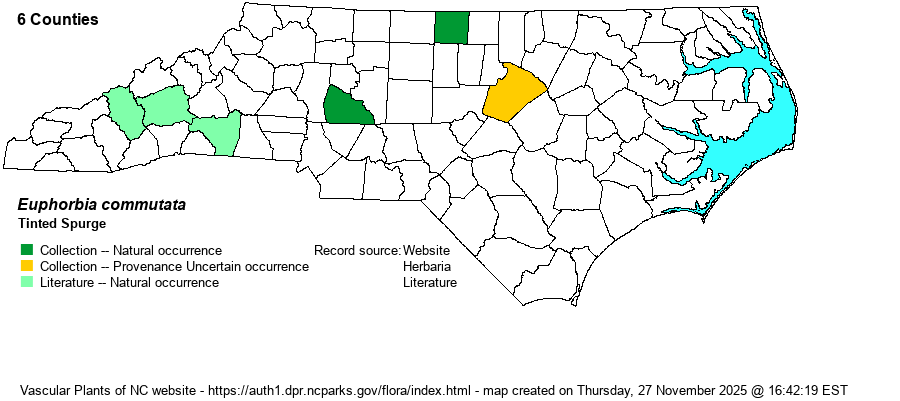| Author | Engelmann ex A. Gray | |
| Distribution | The southern low Mountains currently; historically scattered in the Piedmont (e.g., Caswell County -- "wooded path along Hyco River" in 1939). A specimen at NCSC from Wake County is a student collection without location data, but is accepted by taxon editors, though with questionable provenance in that well-worked county. A specimen at CLEMS from Swain County appears to be a species of Sedum and is rejected. A specimen at CATU from Rowan County has no image (Dunn's Mountain in 2000) but is provisionally accepted pending an ID check. There is a photo on iNaturalist from Buncombe County, in 2024.
PA to southern Ont. and MN, south to northern FL and northeastern TX. Very scarce south of VA (i.e., in NC, SC, and GA). | |
| Abundance | Very rare, and the few extant populations (two or three) seem to be very small. Extremely rare now in the Piedmont. Since this is a small species that can be overlooked, additional undiscovered populations must surely exist, especially as it is so numerous in VA, and should be found in the northwestern parts of NC. This is a State Threatened species.
| |
| Habitat | Mesic to rich, mostly deciduous forests, forests along streams, but can also occur in rocky forested areas; always in higher pH soils, over calcareous or mafic rocks. | |
| Phenology | Flowering and fruiting March-July. | |
| Identification | Tinted Spurge is a rather delicate plant growing mostly just 8-16 inches tall, a few to several stems from the base, with the plant being smooth. Each stem has few or no branches. Leaves are small (less than 1 inch long), elliptical or ovate, widest towards the tip of each leaf, rounded at the apex, and smooth-margined. Inflorescences are small, mostly on branches at the summit of stems. Woodland Spurge (E. obtusata) is similar, but stems are taller (averaging 1.5-2 feet tall) and leaves are finely toothed; it grows in rich bottomlands and floodplain openings, never in uplands or rocky places. Both have yellowish "petaloid appendages"; thus the flowers at the branch tips are a yellow color and not white. | |
| Taxonomic Comments | Named as E. commutatus in older references.
| |
| Other Common Name(s) | Wood Spurge, Tinted Woodland Spurge. Often called Wood Spurge, but as E. obtusata is here named as Woodland Spurge, these two names are too similar and are confusing; in fact E. commutata is at times named as Woodland Spurge as well. | |
| State Rank | S1 | |
| Global Rank | G5 | |
| State Status | T | |
| US Status | | |
| USACE-agcp | FACU link |
| USACE-emp | FACU link |

